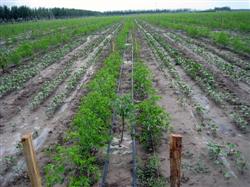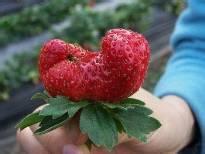How to plant strawberries with high yield and good quality

The common seedling in the field is cultivated in situ by the daughter seedlings on the stolon of the mother plant, and the daughter plants are not separated from the mother plant until the seedlings are removed from the seedling field when strawberries are planted. The characteristics of ordinary seedling raising in the field: the investment in facilities is relatively less and the technical requirements are not high, which is conducive to large-scale and mechanized production. However, grass pests, diseases and insect pests are easy to occur in the southern region with high temperature and humidity. Preparation of seedling field: after the seedling field is selected, deep turning and freezing can be carried out before overwintering, which can eliminate some pathogens and pests on the one hand and help to loosen the soil on the other hand. After the beginning of spring, before strawberry planting, sufficient base fertilizer should be applied, 30kg of superphosphate, 3000-5000 kg of rotten organic fertilizer or 100kg of rotten rapeseed cake per mu, and 0.5kg of 50% phoxim was applied in greenhouse strawberry cultivation techniques to remove underground pests. Combined with basic fertilizer, once again turn over the land deeply and level the ground. After ploughing and raking fine, it is made into a border with a width of 1.2-1.5 meters, a height of 10-20 centimeters and a width of 20-30 centimeters. At the same time, the ditch system around the field must be well opened, waterlogging can be drained and drought can be irrigated, and automatic sprinkler irrigation and drip irrigation devices can be used to maintain moisture in the border soil, so as to provide suitable growth conditions for mother plant growth and stolon emergence. Selection and colonization of mother plant: (1) selection of mother plant. The selection of mother plant directly affects the quantity and quality of stolon seedlings. The stolon seedlings with typical characters of this variety, that is, stolon seedlings with new stem thickness of more than 1 cm, developed root system, normal leaf color, symmetrical leaflets and no diseases and insect pests, were selected as mother plants. If there are conditions, it is best to choose virus-free original seedlings, first-generation seedlings or second-generation seedlings as the mother plant for propagation and production of seedlings. (2) cultivation of virus-free seedlings: cultivation and application of virus-free tissue culture seedlings of strawberries is the most effective way to curb the degradation of excellent characteristics of strawberries caused by virus infection, which can not only improve the disease resistance of strawberries, effectively reduce the use of pesticides, produce high-quality green fruits, make strawberries have high and stable yield, but also effectively protect the ecological environment and speed up the demonstration and promotion of excellent strawberry varieties. (3) planting period: the planting period of mother plant can be planted in autumn or spring. (4) planting density and methods: the planting density in the nursery depends on the ability of the variety to produce stolons, soil fertility and management level. As far as varieties are concerned, varieties such as Saga Qingxiang, Fengxiang and Sweet Charlie have stronger stolon emergence ability, and their density can be lower during planting, while those of Hongqin and Zhang Ji are weaker and their density can be higher at planting. Management after planting: after planting, the mother plant needs to be irrigated with enough water in time and watered again the next day. After that, small water irrigation keeps the soil moist until the strawberry plant is alive. After the mother plant survives, urea is applied once, and urea is applied again every 15-20 days. The application amount should not be too high, so as not to cause burning seedlings. Fertilization of 10 kg per mu can be applied directly around the mother plant without spreading in the whole garden. Fertilization should be mastered before rain, and it can also be poured at a concentration of 0.2%-0.3%. Seedling management: after the mother plant gave birth to the stolon, adventitious roots began to occur from the second section of the stolon, and inserted into the soil to form seedlings. In order to cultivate robust seedlings, the following points should be done during seedling breeding: (1) stolon arrangement: after the mother plant begins to produce stolons, it is necessary to check regularly, straighten out the stolon seedlings in time, and properly open the stolons that are too close to each other, so that the seedlings can be evenly distributed as far as possible to ensure that they have enough living space. For the stolons produced in the later stage, because of the short seedling age, it is difficult to form strong seedlings, so they should be cut off in time to reduce canopy closure in the field and ensure the robust growth of early seedlings. (2) pressing the vine in time: the stolon first grew upward at the initial stage, and the cultivation technique of strawberry interplanting muskmelon in greenhouse crept down when it was close to the leaf height. In order to make the adventitious root on the even node of the stolon go into the soil in time, the vine should be pressed when the seedling has the second unfolded leaf. The method is to press the stolon near the front of the seedling with mud, and it should be noted that it can not be broken. (3) controlling the number of seedlings: in order to cultivate strong seedlings, it is very important to control the number of strawberry seedlings according to the characteristics of different strawberry varieties and the planting density of mother plants, and the number of seedlings per mu should be controlled at about 30 000 ~ 35000 plants. (4) soil, fertilizer and water management: before stolon emergence, the stolon should be ploughed in combination with weeding to keep the soil loose so that stolon seedlings can take root and grow. After the roots of the seedlings are embedded in the soil, 0.2%-0.3% compound fertilizer is irrigated every 15-20 days. If the seedlings grow weakly, 0.2%-0.3% urea water can be irrigated. Nitrogen fertilizer will be stopped after early August, and 0.2% phosphorus and potassium fertilizer will be applied to promote flower bud differentiation. Water management should grasp the principle of keeping the soil moist without stagnant water, and pay attention to drainage and waterlogging prevention when the rainy season comes, especially in the high temperature season after rain in the south, especially to strengthen water management, clear ditches and drain in time, and use sunshade net to cool down when necessary, so as not to burn seedlings with high temperature and high humidity. (5) Control of diseases, insects and weeds: during the period of strawberry breeding, it is necessary to do a good job in the control of diseases, insects and weeds.
- Prev

"eat at the top door" for spring prevention of jujube trees
The autumn management of young jujube orchard is mainly to control fertilizer and water, strengthen soil loosening, promote trunk thickening and Lignification, and create good conditions for young trees to pass the winter. The main technical points of autumn management of young trees are summarized as follows: controlling irrigated jujube trees to tolerate drought, like temperature, sprout late and defoliate early. Young trees should have proper water control.
- Next

Two major factors lead to greenhouse strawberry deformity
According to the investigation and analysis, there are three main causes of deformed fruit, and the corresponding countermeasures can be taken to prevent the occurrence of abnormal fruit. Low room temperature is a common cause of deformed fruit. The optimum temperature for strawberry growth and development was 20-25 ℃. The lowest temperature during flowering and fruiting period should not be lower than 5 ℃, if the temperature is 5 ℃.
Related
- Moge, come on! The staff of the peasant association in the producing area of cantaloupe were frightened when the crowd gathered.
- Causes and Solutions of low Fruit setting rate of Apple
- Symptoms and control measures of passion fruit virus disease
- Fruit growing lesson: how do apple orchards keep high yields?
- Can you build orchards in the mountains? What are the pros and cons?
- How to manage the coloring period of Crisson grape?
- This paper introduces the processing technology of two kinds of fig products.
- How much is a month for retired teachers in rural areas by 2020?
- How can strawberry planting increase sugar content? We should pay attention to management in many aspects.
- What are the cultivation techniques on how to improve the yield of golden fruit?

